ThieAudio V16 Divinity Review - A Truly Divine Sound?
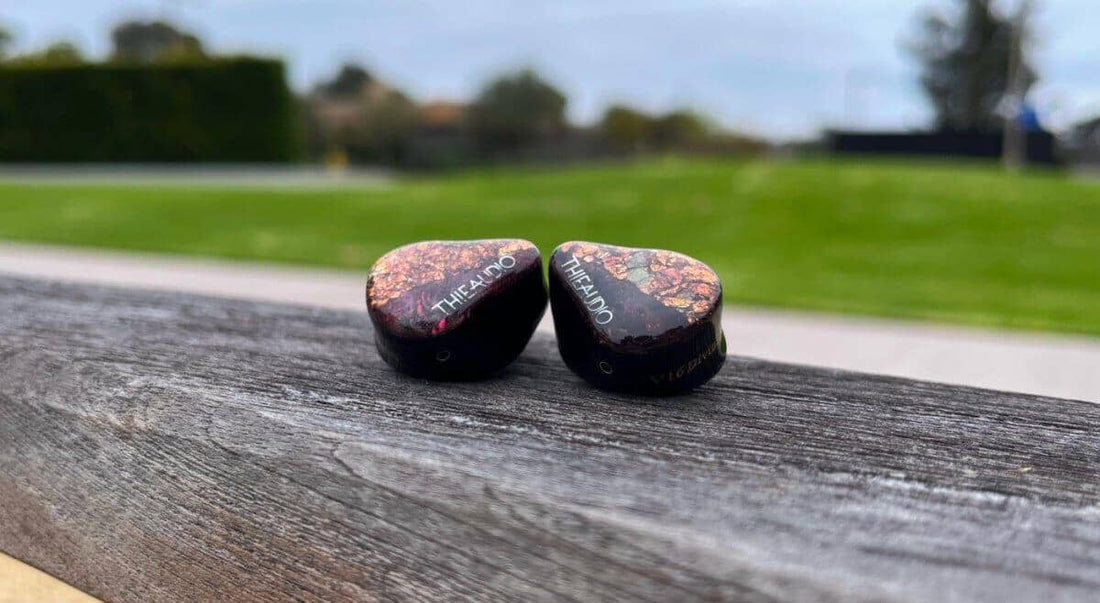
Introduction
ThieAudio is a brand that I have not shied away from criticizing in the past. I've often felt that while they have their tuning down to a near-perfect science, the components used in their IEMs have been more middling and subsequently hampered technical potential. That was, at least, until I heard the ThieAudio Monarch MKII. Despite my healthy initial skepticism, I found the Monarch MKII was truly technical and had the character to be one of the best kilobuck monitors on the market. But perhaps unbeknownst to some readers, ThieAudio released another IEM congruent with the Monarch MKII: the V16 Divinity, a 16BA behemoth. At $1500, the V16 Divinity is ThieAudio's first (and ostensibly, last) foray in to the flagship arena. The V16's pricing combined with the strong precedent the Monarch MKII set means that I approach the V16 with higher expectations and a more critical ear than ever. Read on to find out whether ThieAudio's self-proclaimed tour de force delivers.
This unit was loaned for review courtesy of reader "OGK". Thank you! As always, what follows are my honest thoughts and opinions to the best of my ability.
Source & Drivability
All critical listening was done off of an iBasso DX300 and iPhone 13 Mini using lossless files. The stock cable and the stock silicone tips were used. The V16 Divinity is very sensitive, enough that there was audible hissing off of both sources I used above. For these reasons, I threw in an iFi IEMatch for most of my listening. If you'd like to learn more about my listening methodology and test tracks, please see this page.
In-the-Box
If there's anything I appreciate, it's ThieAudio's continued dedication to improving the quality of their packaging and accessories. The V16 Divinity follows in the footsteps of the Monarch MKII, sporting a sleeker package that reminds me of the 64 Audio IEMs. Inside, the following accessories are included:
- Microfiber cleaning cloth
- 2-pin 0.78mm cable terminated in 3.5mm
- 2.5mm and 4.4mm adapters
- carrying case
- silicone and foam ear tips
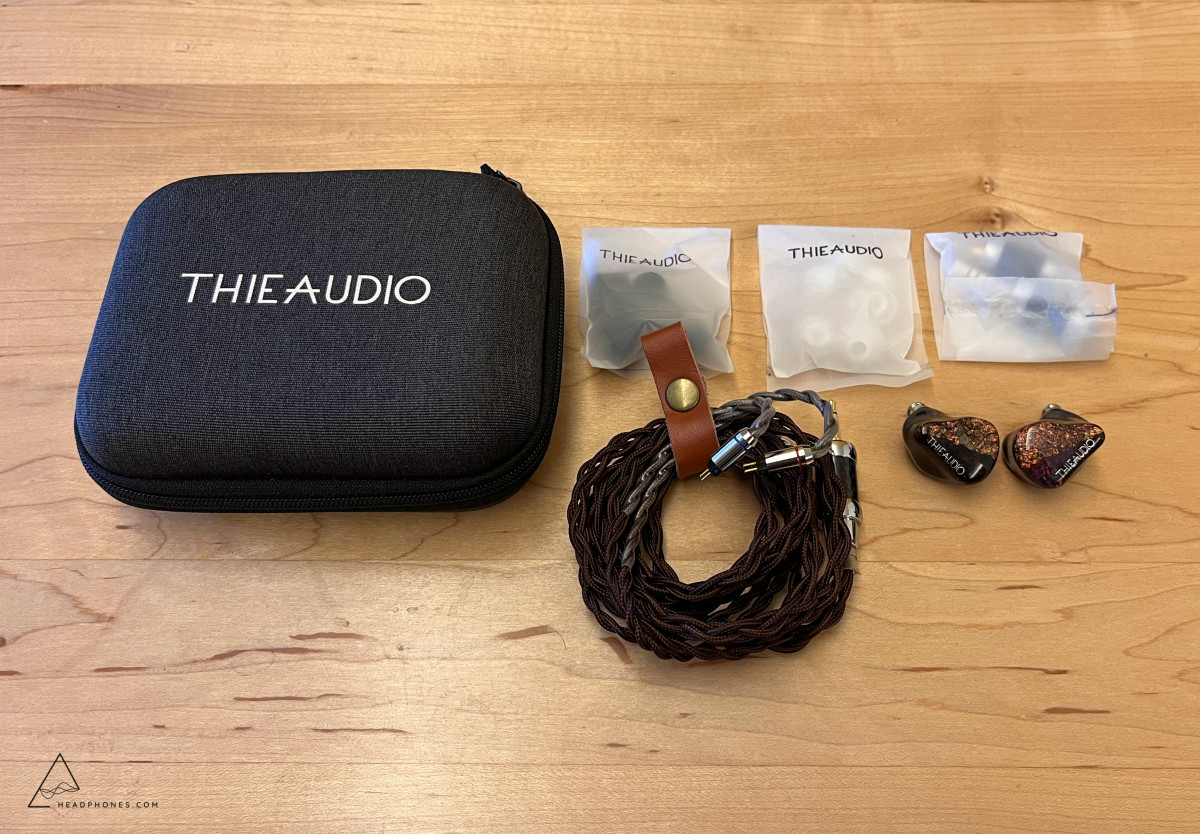
The cable included with the V16 utilizes brown paracord and high-quality, metal hardware. It's definitely on the heavier side, so be aware that it might place some strain around the ears. That aside, it seems like interchangeable terminations are slowly becoming a trend, and I do like the one included with this cable. It's not quite as advanced as DUNU's legendary cables in that this one's just a pull-and-plug, but the quality is solid and it doesn't protrude like mad.
The case that comes with the V16 appears to be a middle-sized version of the two cases that were included with the ThieAudio Legacy 4. It's made out of synthetic fabric with a mesh pocket on the inside so that you can store some accessories. You won't have any trouble getting your IEMs in there or storing this case in a backpack; however, it might be difficult to pocket given the larger size.
The V16 is a large IEM, but I find comfort to be manageable not unlike the Empire Ears IEMs. The shell is contoured in a very natural way for my ears even if it can get uncomfortable after a couple hours. Your mileage will vary per usual of course. Aesthetically, the V16 is reminiscent of the binary faceplate that characterized the ThieAudio Monarch and Clairvoyance IEMs, but with a more mature, dark gold and red color scheme. The color and weight of the cable also compliments these decisions well in my opinion.
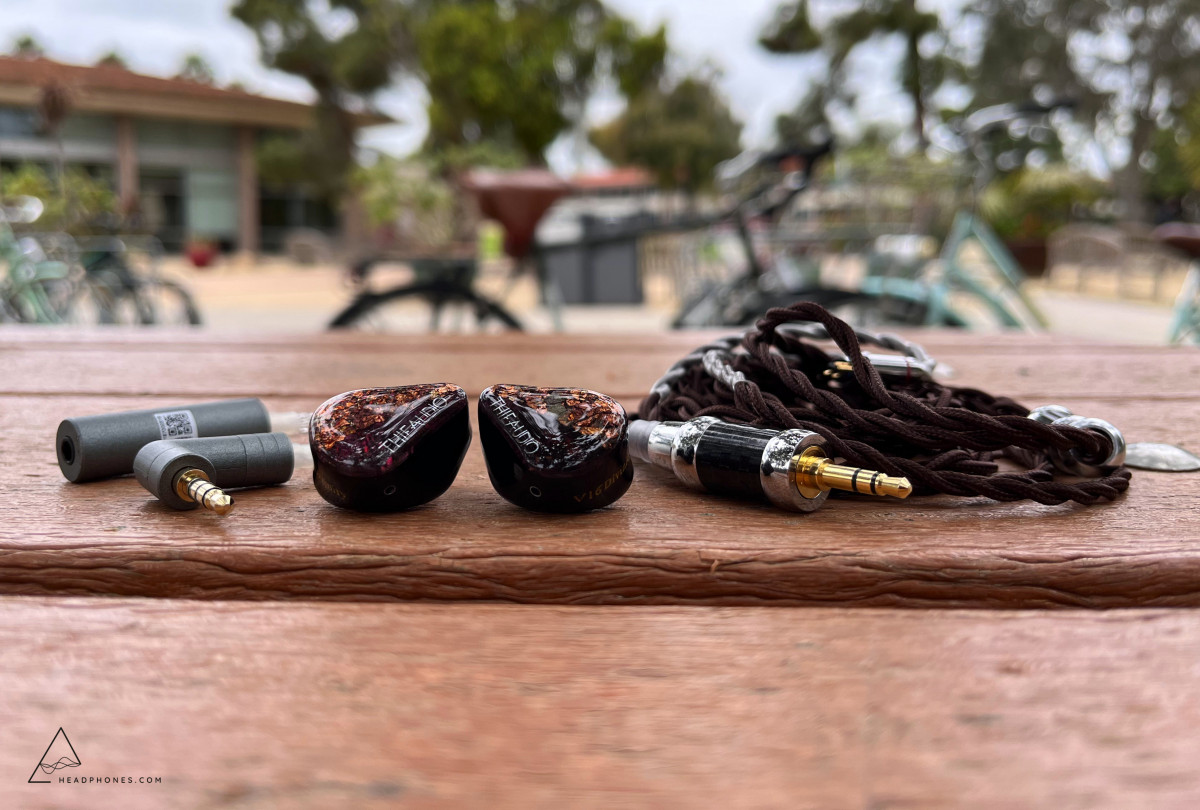
Sound Analysis
The frequency response below was taken off of an IEC-711 coupler. There is a resonance peak at roughly 8kHz, so measurements after this point should not be considered entirely accurate. You can follow this link to compare the V16 Divinity to other IEMs that I have graphed.
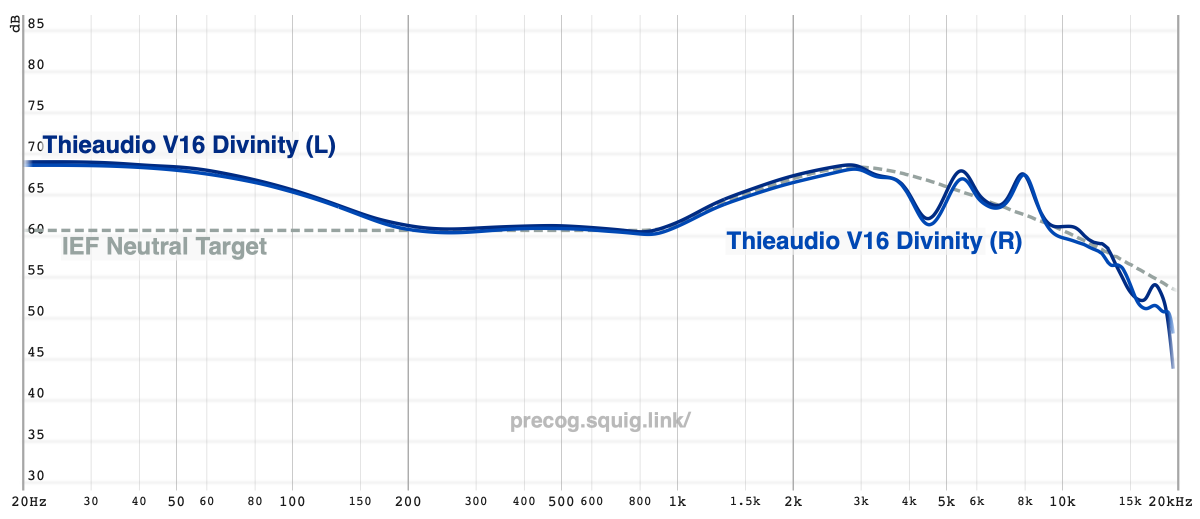
The bass of the V16 is some of the better BA bass I've heard. It's darn good from a tuning aspect with gobs of sub-bass and a curve that slopes off cleanly into the lower-midrange at 200Hz. Intangibles are not too shabby either; there's a sense of impact that belies the BA drivers being employed. However, I do feel that bass decay is not quite where I'd like it to be. It's a funny thing to say - especially given that we're talking about a BA IEM - but notes can sound almost excessively boomy with too much 'thump' at times on the V16. It follows that control is probably not as good as I think it should be for a BA monitor. At the end of the day, the bass of the V16 can be best summarized as a "fun" bass response that sacrifices some of the refinement that I've heard from the best BA bass.
Here's where things start getting iffy; the midrange of the V16 strikes me as somewhat odd. It tracks very closely to IEF's neutral target up until around 4kHz, at which point there's a recession. This recession has the effect of skewing midrange note-weight thicker and killing sibilance, but I don't think the balance struck here is quite ideal. When my favorite soprano vocalist, Taeyeon, belts on "Fine" (on the "iiiine" part at 1:04), she sounds upfront and present, yet there is a muted characteristic to the upper-registers of her voices that triggers some uncanniness by contrast. In any case, IEMs that go for these types of presence-region recessions tend to have a more relaxed pinna compensation (from 1-3kHz) à la the 64A IEMs, begetting a smoother presentation. Intangibly, I don't find myself satisfied with the V16's midrange either. Timbre is generally plasticky and lacks vibrancy, and it only goes further downhill from here.
Most who have read my reviews before will be aware that I never thought that ThieAudio's EST treble implementations were all that good. You can call me a hater, but I would attest that the V16's BA treble implementation is even worse. The V16's treble response is unremarkable. Bland. Dry. Compressed. Makes me want to fall asl - actually, I think you get the idea. Stick impact between rapid hits is undefined and hazy on SNSD's "Into the New World"; curiously, the peak at ~6kHz does not actually sound very present if you ask me. And that's ignoring the lack of air, the lack of upper-treble shimmer. The V16 has less presence past 15kHz than the ThieAudio Monarch MKII which - for reference - I already felt was pushing it. Now, let there be no mistake: the overall tonal balance of the V16 is still not bad in that it aligns with what some might deem a more 'natural' response, but it's really on the short end of the stick in terms of intangibles.
Technical Performance
Criticism about the treble aside, the V16 is still definitely a highly resolving IEM. I say this in the sense that micro detail, reverb trails and texturing to the end of vocals, are present despite a lack of perceived micro-contrast. This is where that slight sense of grain-ness to notes is a boon and makes the V16 sound more detailed than I think it might really be. And to this end, I do feel that the V16's bass detail and treble detail are more questionable as I've alluded to above.
Likewise, for a sense of incisiveness to instrument position, I don't find myself enamored with the V16. Perhaps a basis of comparison would help: I'd consider the V16's younger brother, the Monarch MKII, to actually be the stronger performer for imaging from memory. While neither has exceptional stage size, notes on the Monarch MKII were pinpoint precise on the stage for which I cannot say the same of the V16. Like the OG Monarch, the V16 has some layering issues wherein instruments tend to get squeezed on the stage on more complex tracks.
The V16's macro-dynamics are...acceptable. It certainly sounds (or more closely, feels) like the V16 is pushing more air than the other ThieAudio's IEMs I've heard, which is a welcome change of pace. But for sheer contrast of decibel gradations, macro-contrast, the V16 takes on a more subdued quality. Take for instance passages on less compressed music such as Steve Jablonsky's "We Have to Go" wherein the steady crescendo to peak volume seemingly never gets past the volume in the middle of the track. Or take Sawano Hiroyuki's "scene" wherein the abrupt hits to the piano keys at 1:00 and 2:00 lack intensity and a sense of immediacy from the antecedent dead silence.
How does the ThieAudio V16 compare to the 64A U12t?
And I took that personally just kidding. But this does seem to be a popular question that I've been seeing on the forums and I have both on-hand for direct A/B, so hey, why not?

Tonally, I'd say the ThieAudio V16 falls closer to neutral with sub-bass boost whereas the 64A U12t is more U-shaped. Both have their individual colorations, but this means that the U12t's female vocal presentation is more relaxed and there is considerably more presence in the 15kHz regions for a sense of shimmer up-top.
For the most part, the BA bass on the two IEMs trades blows. The V16 exhibits perhaps a tad more reverb and 'thump' at the expense of control relative to the U12t. However, this does mean that the U12t actually 'slams' harder and digs deeper, as I find the perception of slam is often aided by the sense of immediacy that comes from cleanly delineated bass notes. The midrange of the V16 is generally more upfront, positionally, whereas the U12t's midrange is more diffuse in its presentation. Treble-wise, the U12t has more energy in the lower and upper-treble regions which gives it greater shimmer and sharpness to percussive hits (for which those with more sensitive hearing might find annoying).
In terms of technicalities, I do think there's a clear winner in terms of the metrics I index for: The V16 is simply not as refined as the U12t. The V16 matches the U12t for midrange micro-detail, but there's a decent gap for bass detail which only grows come their respective treble responses. Imaging on the U12t is also more precise, more expansive; it doesn't stumble as much when pressed with multiple instrument lines in the same location despite the V16's more neutral frequency response. Furthermore, timbre-wise, the V16 has a more conventional "BA" presentation wherein there's more grit and plasticky-ness to notes. And expectedly, there is little comparison for dynamic contrast which really pops on the U12t. Quite frankly, the components being employed in the U12t and the tonal balance it strikes are just on another level to my ears.

The Verdict
But of course, the 64A U12t is $500 more than the V16, so it's not a completely fair comparison. As a further assessment of value then, the V16 is basically in no-man's territory at $1500 which is not necessarily a bad place to be...if it were competitive. The problem? As I see it, the V16 doesn't really offer much over the established kilobuck monitors (the Symphonium Helios, ThieAudio Monarch MKII, Sony IER-M9, etc.) to justify the price increase. In many cases, I'd even argue that the established kilobuck monitors sound better!
As I alluded to in my introduction, we've observed this trend before with a number of ThieAudio's IEMs: well-tuned, fairly technical, but lacking the special sauce that would make them stand out. And you really need special sauce if you want to play at the flagship level. Unfortunately, that's not what I hear with the V16 Divinity, and while it's by no means a bad buy, I'd recommend giving it a pass for some of the really special IEMs you can find in the flagship bracket.
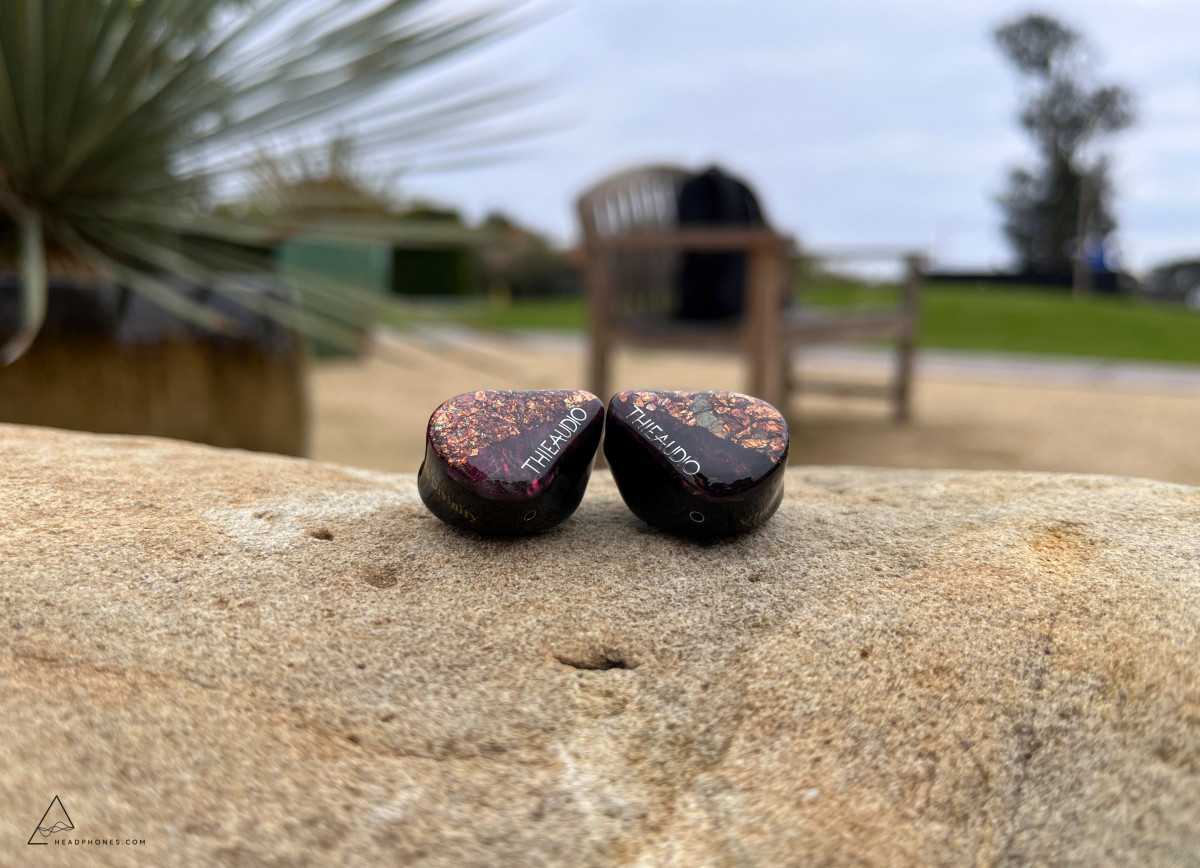
You can purchase the ThieAudio V16 Divinity here.
---
Discuss the Thieaudio Divinity V16 on the HEADPHONE Community Forum here.
---
